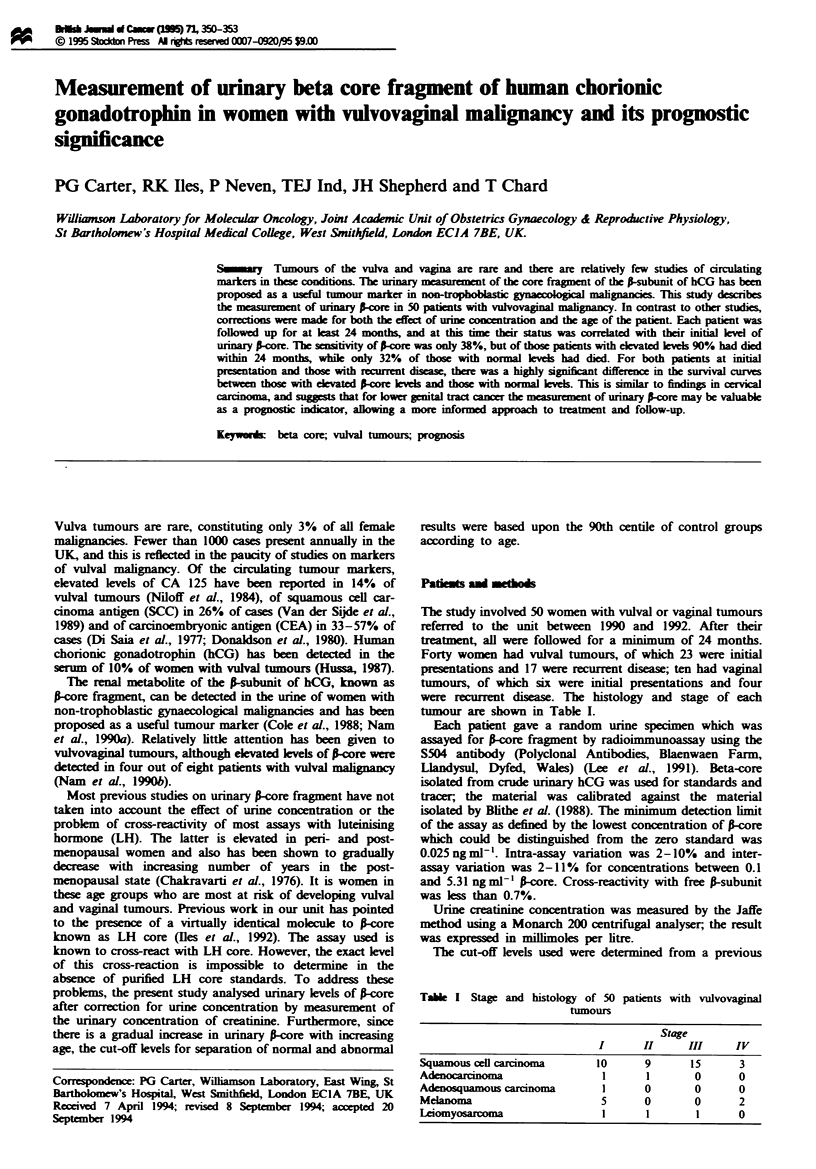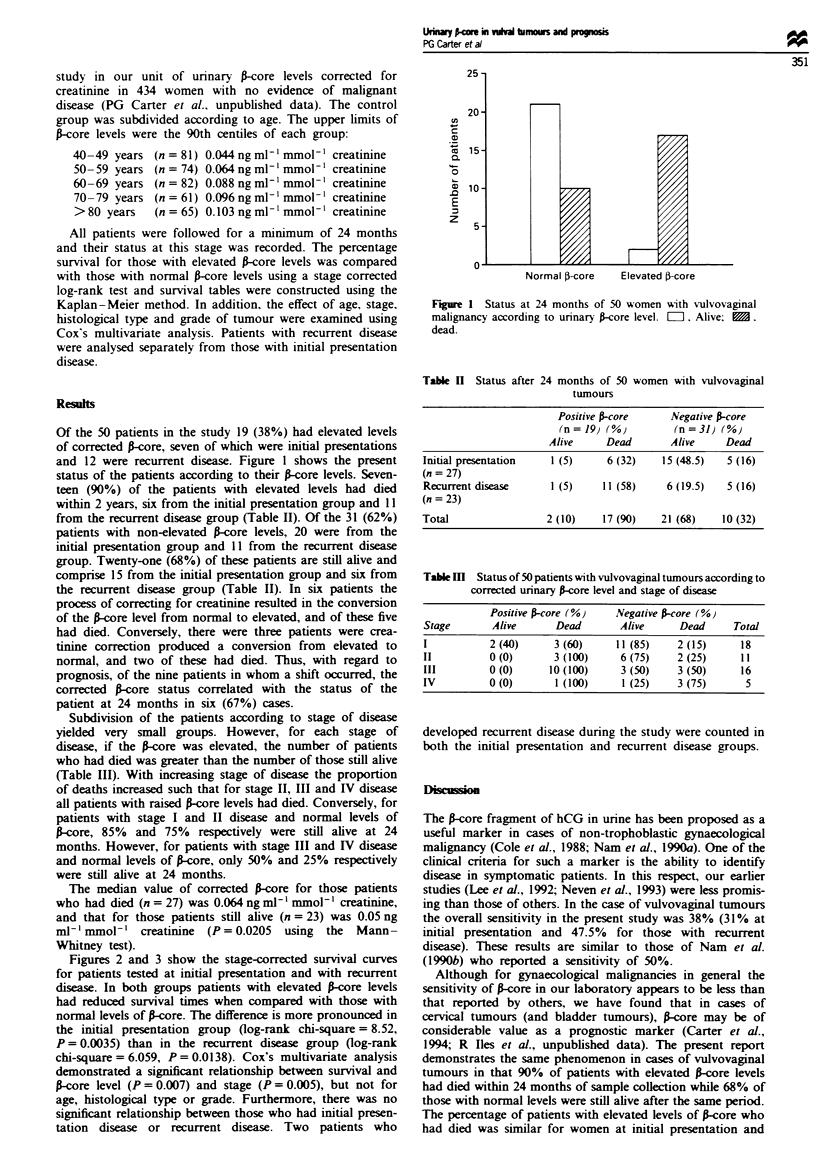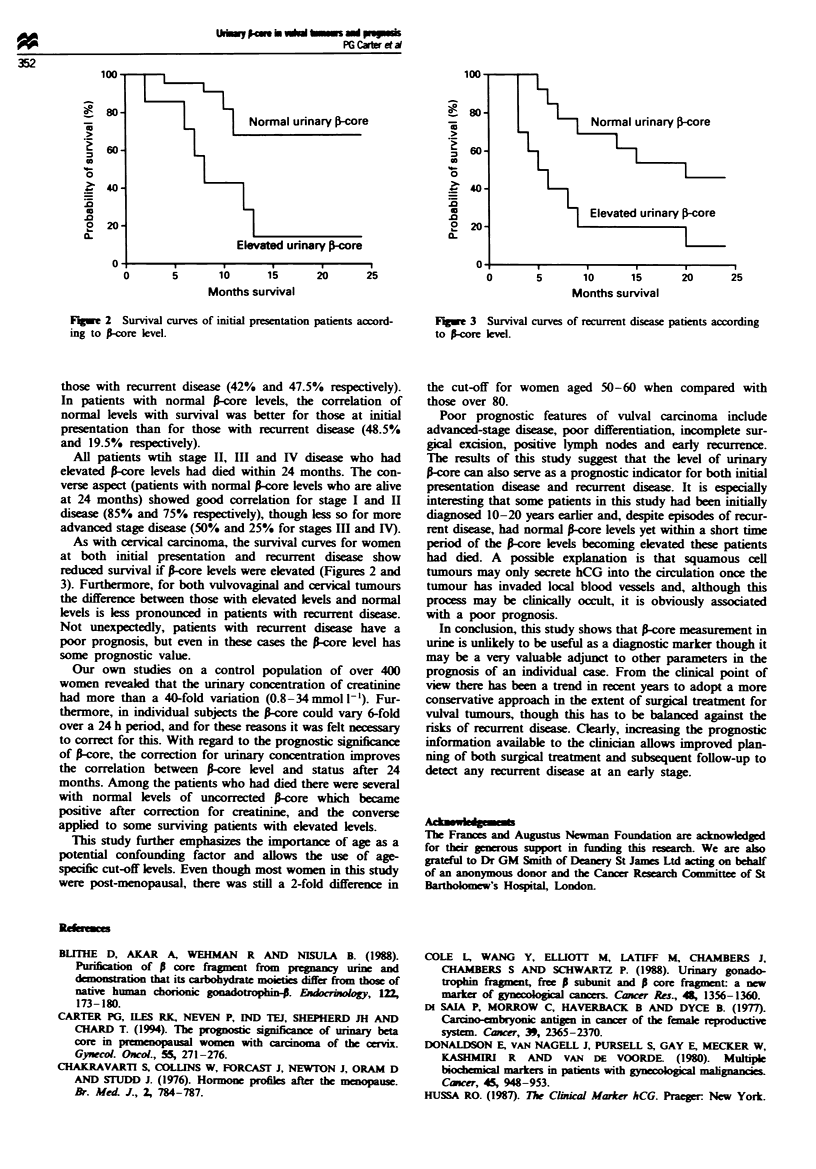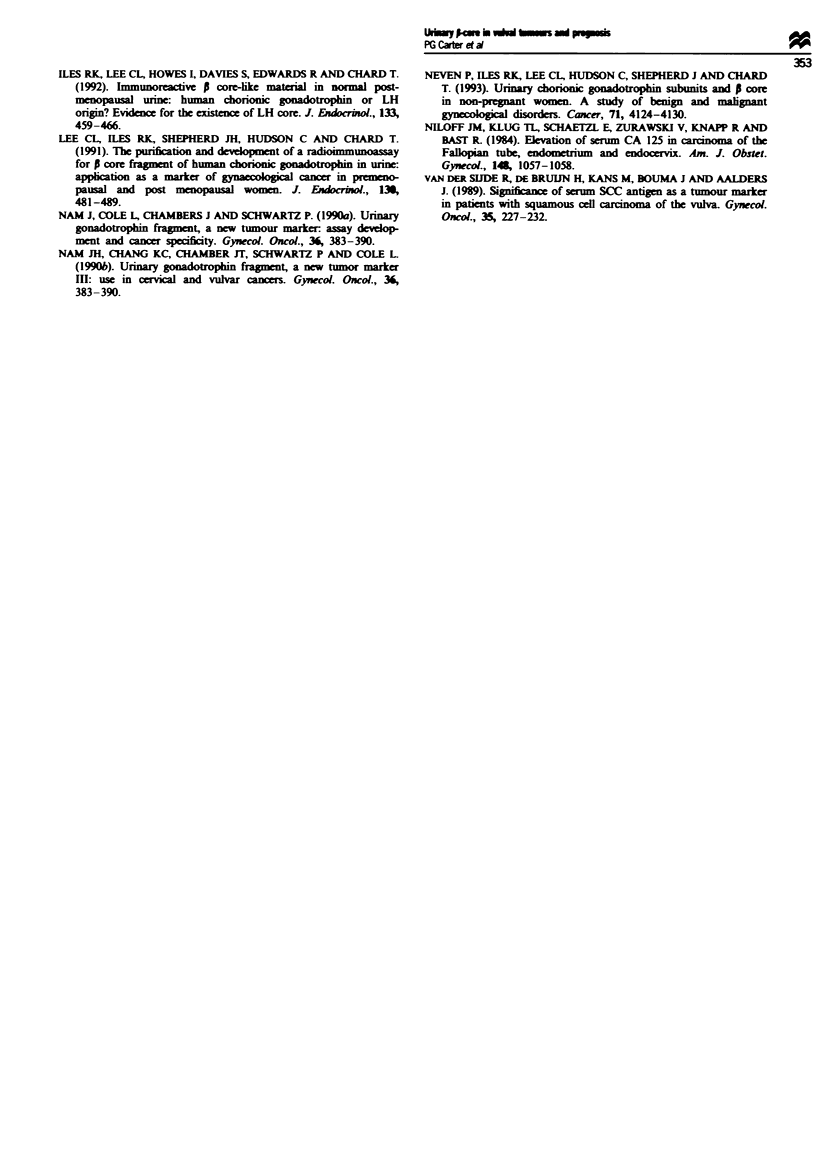Abstract
Tumours of the vulva and vagina are rare and there are relatively few studies of circulating markers in these conditions. The urinary measurement of the core fragment of the beta-subunit of hCG has been proposed as a useful tumour marker in non-trophoblastic gynaecological malignancies. This study describe the measurement of urinary beta-core in 50 patients with vulvovaginal malignancy. In contrast to other studies corrections were made for both the effect of urine concentration and the age of the patient. Each patient was followed up for at least 24 months, and at this time their status was correlated with their initial level of urinary beta-core. The sensitivity of beta-core was only 38%, but of those patients with elevated levels 90% had died within 24 months, while only 32% of those with normal levels had died. For both patients at initial presentation and those with recurrent disease, there was a highly significant difference in the survival curve between those with elevated beta-core levels and those with normal levels. This is similar to findings in cervical carcinoma, and suggests that for lower genital tract cancer the measurement of urinary beta-core may be valuable as a prognostic indicator, allowing a more informed approach to treatment and follow-up.
Full text
PDF



Selected References
These references are in PubMed. This may not be the complete list of references from this article.
- Blithe D. L., Akar A. H., Wehmann R. E., Nisula B. C. Purification of beta-core fragment from pregnancy urine and demonstration that its carbohydrate moieties differ from those of native human chorionic gonadotropin-beta. Endocrinology. 1988 Jan;122(1):173–180. doi: 10.1210/endo-122-1-173. [DOI] [PubMed] [Google Scholar]
- Carter P. G., Iles R. K., Neven P., Ind T. E., Shepherd J. H., Chard T. The prognostic significance of urinary beta core fragment in premenopausal women with carcinoma of the cervix. Gynecol Oncol. 1994 Nov;55(2):271–276. doi: 10.1006/gyno.1994.1289. [DOI] [PubMed] [Google Scholar]
- Chakravarti S., Collins W. P., Forecast J. D., Newton J. R., Oram D. H., Studd J. W. Hormonal profiles after the menopause. Br Med J. 1976 Oct 2;2(6039):784–787. doi: 10.1136/bmj.2.6039.784. [DOI] [PMC free article] [PubMed] [Google Scholar]
- Cole L. A., Wang Y. X., Elliott M., Latif M., Chambers J. T., Chambers S. K., Schwartz P. E. Urinary human chorionic gonadotropin free beta-subunit and beta-core fragment: a new marker of gynecological cancers. Cancer Res. 1988 Mar 1;48(5):1356–1360. [PubMed] [Google Scholar]
- DiSaia P. J., Morrow C. P., Haverback B. J., Dyce B. J. Carcinoembryonic antigen in cancer of the female reproductive system. Serial plasma values correlated with disease state. Cancer. 1977 Jun;39(6):2365–2370. doi: 10.1002/1097-0142(197706)39:6<2365::aid-cncr2820390609>3.0.co;2-i. [DOI] [PubMed] [Google Scholar]
- Donaldson E. S., van Nagell J. R., Jr, Pursell S., Gay E. C., Meeker W. R., Kashmiri R., van deVoorde J. Multiple biochemical markers in patients with gynecologic malignancies. Cancer. 1980 Mar 1;45(5):948–953. doi: 10.1002/1097-0142(19800301)45:5<948::aid-cncr2820450519>3.0.co;2-q. [DOI] [PubMed] [Google Scholar]
- Iles R. K., Lee C. L., Howes I., Davies S., Edwards R., Chard T. Immunoreactive beta-core-like material in normal postmenopausal urine: human chorionic gonadotrophin or LH origin? Evidence for the existence of LH core. J Endocrinol. 1992 Jun;133(3):459–466. doi: 10.1677/joe.0.1330459. [DOI] [PubMed] [Google Scholar]
- Lee C. L., Iles R. K., Shepherd J. H., Hudson C. N., Chard T. The purification and development of a radioimmunoassay for beta-core fragment of human chorionic gonadotrophin in urine: application as a marker of gynaecological cancer in premenopausal and postmenopausal women. J Endocrinol. 1991 Sep;130(3):481–489. doi: 10.1677/joe.0.1300481. [DOI] [PubMed] [Google Scholar]
- Nam J. H., Cole L. A., Chambers J. T., Schwartz P. E. Urinary gonadotropin fragment, a new tumor marker. I. Assay development and cancer specificity. Gynecol Oncol. 1990 Mar;36(3):383–390. doi: 10.1016/0090-8258(90)90148-e. [DOI] [PubMed] [Google Scholar]
- Neven P., Iles R. K., Lee C. L., Hudson C. N., Shepherd J. H., Chard T. Urinary chorionic gonadotropin subunits and beta-core in nonpregnant women. A study of benign and malignant gynecologic disorders. Cancer. 1993 Jun 15;71(12):4124–4130. doi: 10.1002/1097-0142(19930615)71:12<4124::aid-cncr2820711252>3.0.co;2-p. [DOI] [PubMed] [Google Scholar]
- Niloff J. M., Klug T. L., Schaetzl E., Zurawski V. R., Jr, Knapp R. C., Bast R. C., Jr Elevation of serum CA125 in carcinomas of the fallopian tube, endometrium, and endocervix. Am J Obstet Gynecol. 1984 Apr 15;148(8):1057–1058. doi: 10.1016/s0002-9378(84)90444-7. [DOI] [PubMed] [Google Scholar]
- van der Sijde R., de Bruijn H. W., Krans M., Bouma J., Aalders J. G. Significance of serum SCC antigen as a tumor marker in patients with squamous cell carcinoma of the vulva. Gynecol Oncol. 1989 Nov;35(2):227–232. doi: 10.1016/0090-8258(89)90049-8. [DOI] [PubMed] [Google Scholar]


